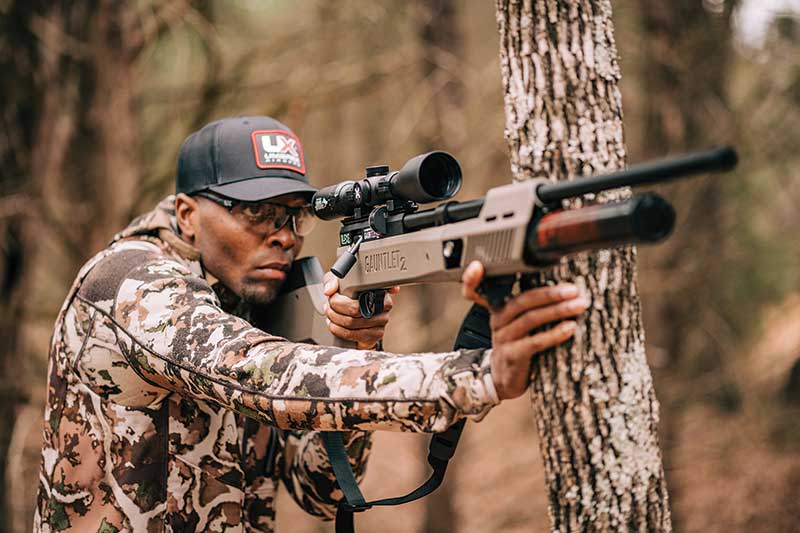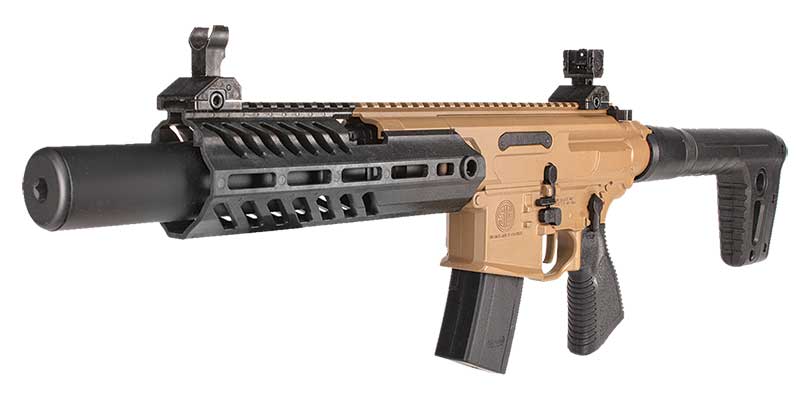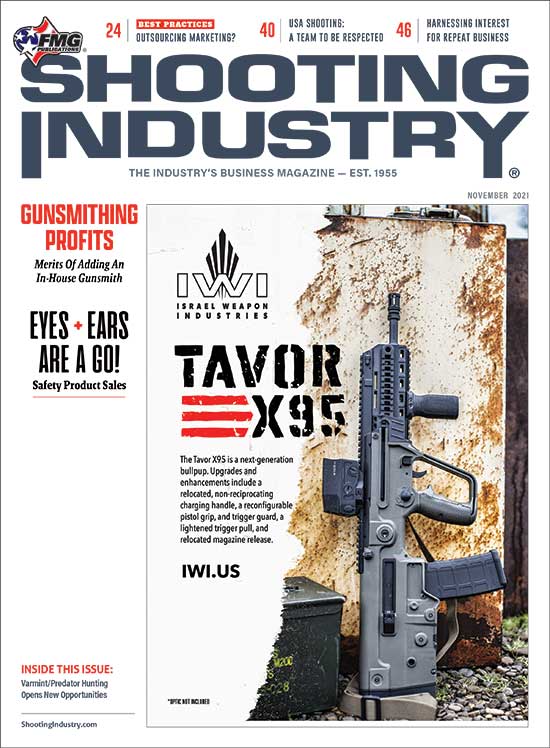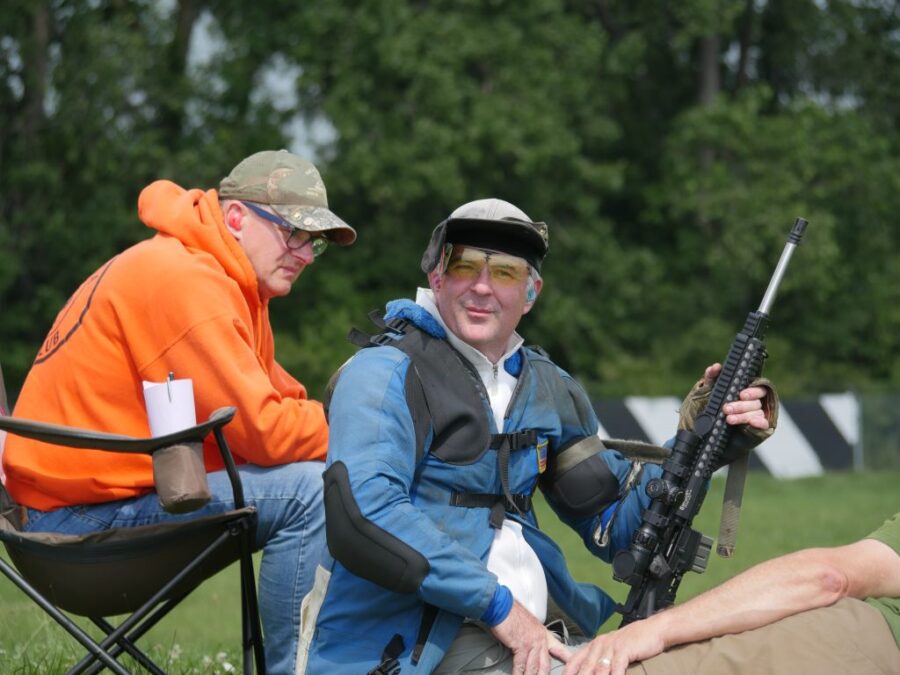Airguns Mean Business
Where Plinking, Precision, Education
& Hunting Uses Meet
If you ever find yourself looking around your store, exploring different options for filling empty shelf space, you might want to consider airguns. Given the ongoing scarcity of ammo, you might want to consider them sooner rather than later.
To be clear, we’re not suggesting airguns have any hope of satisfying the needs of customers looking for real firearms, particularly for self-defense. But for plinking and education applications, they certainly have a place.
Initiating “Newbies” & Kids
Randy Potter is manager of GAT Guns in East Dundee, Ill., where they’ve been selling airguns for more than two decades. During the recent firearms buying frenzy, Potter noticed an interesting trend.
He has seen strong growth in what he calls “replica” guns — the CO2-powered airguns designed to look like popular firearms, including the 1911 and the SIG SAUER P320 platforms.
“The guns we’ve been selling a lot of are the ones that mimic actual firearms people have been buying over the past year and a half,” Potter noted.
He doesn’t think it’s a coincidence. With the ammo shortage, it gives people the opportunity to get close to the feel of handling their real guns. And while they’re not real firearms, it doesn’t mean they come cheap — with prices ranging from $70 to $300.
“They’re really just kind of for hobbyists and plinking; they’re not the sort of guns you’re going to go hunting with,” he said. “But you can train the kids on them. You can teach them proper gun handling.”
Indeed, airguns can be an excellent training tool for introducing newbies to firearms.
At Kentucky Gun Company in Bardstown, Ky., it’s a primary driver of sales in the segment. Owner Patrick Hayden said it’s not uncommon for parents to grab an air rifle as a starter gun for youngsters.
“They’re easier to handle. They have low recoil and low noise. It’s just a real gentle way to introduce kids to the shooting sports,” Hayden observed. “Then, they’ll eventually graduate to a .22 rifle, deer rifle or shotgun.”
Both stores have seen modest growth in the segment in recent years, with industry advances making some of the more powerful PCP rifles — and the air compressors used to fill them — more affordable.
Still, they’re not setting aside large chunks of real estate for air gunners.
At the Kentucky store, for example, there’s only one 10′ shelf segment dedicated to airguns out of some 20,000 sq. ft. of retail space.
“It’s enough to carry 20–30 different models and all the accessories they need,” Hayden added.
Those accessories include BBs, pellets, cases, slings, eye/ear protection and special optics — airgun scopes built to handle recoil different from that of a firearm. There’s also a market for airgun targets, including lightweight spinners. “The kids still want to see the spinner spin,” Hayden remarked.
Finding Your Market
The small, but growing, market comprises a wide range of options. At the bottom of the sector are those toy versions of firearms, generally powered by CO2 or variable pumps. At the top end of the market are break-barrel rifles and pre-charged pneumatic (PCP) rifles that represent the serious side of the business. These are pricey and powerful enough to be used for hunting.
“Pest control in our part of the country is the biggest draw,” Hayden shared. “We’ve also got some customers who squirrel hunt with them.”
Before delving into the sector, the trick is figuring out what (and what not) to stock.
For GAT Guns, it means focusing on the middle of the market — pricier than what people will find at local department stores, but less expensive than the stuff carried by online specialty shops.
“I can’t sell Red Ryders because Walmart is selling them at cost,” Potter observed. “And you have online companies out there having their own stuff built. They own the category.”
GAT Guns has done well with those replica CO2 guns (made by SIG SAUER and Umarex) on the lower end. While PCP guns (the Benjamin Marauder is popular) have become more affordable, the store still does its best business with break-barrel rifles.
“As long as they are in the $250 range, we can sell a lot of them,” he said. “Once they get over that line, we don’t sell too many.”
GAT Guns has done well with those replica CO2 guns on the lower end. While PCP guns have become more affordable, the store still does its best business with break-barrel rifles.
The most expensive rifle GAT carries is the RWS Model 54 Air King at $799. The gun fires a .177-cal. pellet at 1,100 fps.
“You could hunt small game with it for sure,” Potter noted. “I think most of our customers are using them for recreational shooting with occasional pest control.”
Another thing to consider is airgun sales won’t necessarily lead to more airgun sales down the road for any particular customer. It’s rare to find someone who’s collecting airguns the same way firearm customers might be working to fill up a safe at home.
“For most people, it’s a one-off niche,” Potter said. “You’ll sell them one or two guns and then they’re usually done.”
The situation is similar in Kentucky, where Hayden breaks up the segment into options costing less than $300 and those in the $500–$1,000 range. He prefers to stick with the lower segment, focusing on brands like SIG SAUER, Umarex, Daisy, Gamo and Stoeger.
On The Higher End
The problem with the pricier rifles is you’re unlikely to have a solid base of customers in your area willing to spending $1,000 on an airgun.
“We just haven’t had a lot of demand for the high-end stuff,” Hayden said. “There’s just not a whole lot of those guys out there.”
Still, they do cater to this group in smaller ways.
For example, they’ll put in special orders for those customers looking for something more powerful — bringing in guns from companies like AirForce Airguns, which offers rifles in calibers including .308, .357, .457 and .50.
They also carry handpumps designed to recharge the beefier guns. It’s a labor-intensive option for airgunners without their own compressors. And along those lines, the store also has an industrial-strength compressor onsite to do refills for a few dollars.
“You can’t just use one of those air compressors you find on the shelf at Lowe’s,” he added.
The challenge of carrying the higher-end rifles is similar to what any store that has tried dipping a toe into the custom 1911 market faces. The more people are willing to spend on a gun, the pickier they become about exactly what features they expect to find on said gun.
Concluded Potter, from GAT Guns: “It seems like every time I try to put a gun like that on the shelf, it’s not exactly what everyone wants.”
Dealers, what trends have you observed in the airgun category? What’s your outlook on the market? Let the SI team know: comments@shootingindustry.com.








